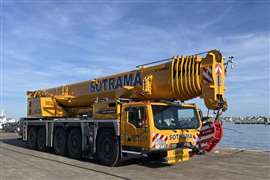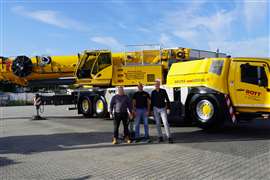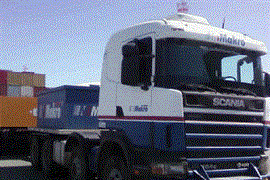Why BIM is important for the crane industry
10 March 2022
What is BIM and why is it important for the crane industry to know about it? Is it just the latest digital fad or will it change the construction process forever? Niamh Marriott reports.
With the pandemic accelerating digitalisation, many businesses have seen the benefits that come with integrating new technology into their operations, such as BIM. Improved efficiency, realisation of environmental, social and governance (ESG) objectives, and an empowered workforce, are some of the benefits that come with integrating new technology.
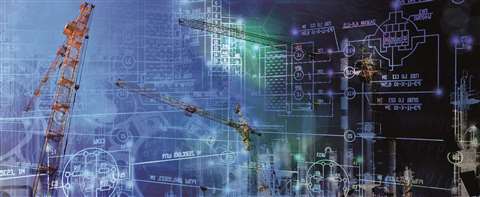 BIM encompasses the entire process of a building or buildings (Image: Adobe)
BIM encompasses the entire process of a building or buildings (Image: Adobe)
New research has found many companies are still using outdated business processes, says Sourcing Industry Group (SIG). A recent study of more than 150 global companies, organised by SIG in association with artificial intelligence-powered procurement platform Globality, found that only 6 per cent of companies have fully embraced digital transformation. This lack of adoption is reflected too in construction, site management and crane rental businesses.
What is BIM?
So, let’s start with the basics as BIM, building information modelling, is still a relatively new concept for the industry, and for construction. The concept of BIM has been in development since the 1970s, but it only became an agreed term in the early 2000s, where its popularity has slowly increased.
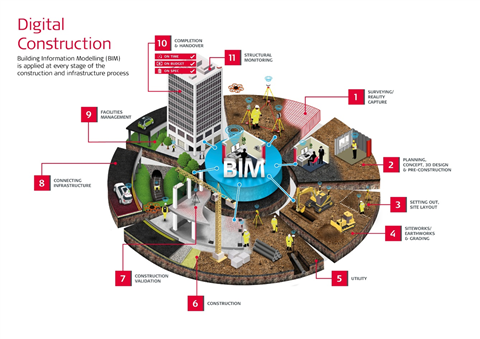 Building Information Modelling (BIM) is applied at every stage of construction (Image: Leica Geosystems)
Building Information Modelling (BIM) is applied at every stage of construction (Image: Leica Geosystems)
The idea of the smart modelling is to encompass the entire process of a building or buildings, from conception to completion, acknowledging and including all parties involved. It allows the planning, design and physical build to be optimised. It is a collaborative digital approach to construction.
In theory, any company or person involved in the building, from architects, designers, developers and contractors, to manufacturers and other construction professionals, can view the digital plans and make amendments, changes or updates. Known as open BIM, the design is available to view and alter. It’s designed to make sure that nothing will be missed, ignored or overlooked – and aims to make the entire process super efficient. Every person working on the project would be working from one model.
More recently, BIM is also being used post-construction, to optimise the use of the building and the services and energy it requires, and to make informed decision about the building. Management, operations team, owners and overseers can all use the BIM model.
“While the adoption of BIM is on the increase, in many cases it is only being used at the early stages of design and construction,” says Simon Hall, Leica Geosystems’ content marketing executive.
Why BIM is better
Computer aided design (CAD), widely used in recent years to produce a 3D model of a building, can be useful for all types of service providers in construction to get a full image of a design. BIM goes further than CAD and offers real information, that is not just available, but “actionable,” comments a Trimble spokesperson. Users can add not only the material information of buildings components, but also the scheduling, cost estimations, budgeting, and sustainability of all parts. The time it will take to complete each section can be included, as well as data on who is providing what, from where and when. Energy consumption requirements are recorded, which can lead to a more sustainable way of working, and the sequence of each task is outlined.
Worldwide adoption?
Different countries have different approaches to mandating and-or encouraging the use of BIM. Dubai Municipality issued a circular (196) in 2014 mandating BIM use for buildings of a certain size, height or type. In December 2015 Germany’s minister for transport, Alexander Dobrindt, announced a timetable for the introduction of mandatory BIM for German road and rail projects from the end of 2020. The Russian government has approved a list of the regulations that provide the creation of a legal framework for the use of information modelling of buildings in construction and encourages the use of BIM in government projects. Spain’s Ministry of Infrastructure (Ministerio de Fomento) launched the country’s national BIM strategy, making BIM a mandatory requirement on public sector projects, although no firm date has been set for this. The USA has not adopted a set of national BIM guidelines, allowing different systems to remain in competition. Many contractors, architects and developers are experimenting with BIM.
There’s also some discussion in North America over the actual wording, and alternatives like Virtual Building Environment (VBE) are being debated.
UK-based NBS (National Building Specification) published its 10th annual BIM report in 2020 and found adoption is widely increasing. It stated that in 2011, 43 % of its survey respondents had not heard of BIM, while in 2020, 73 % said they were using BIM.
How can cranes benefit?
Cranes are a sizeable part of big construction sites, and account for a reasonably large part of the overall budget on a project. Optimising their use on site and being aware of exactly how they fit into the process can save time, money, energy and fuel. It can therefore be incredibly useful to consider BIM.
Simon Hall says, “Improved digital construction practices and tools can help bring projects in on time and on budget by making everyone involved more productive and eliminating mistakes. The sharing of information in the form of digital data between all parties, through all stages of the construction process from concept to completion, can help bring the industry into the future and reduce legacy challenges such as delays and cost overruns.”
Ultimately, using BIM can result in “a reduction in design flaws, better budgeting and fewer problems with operations and maintenance integration,” comments Hall. These are common problems with fleet management and rental and could be addressed and resolved early with this digital adoption, and benefit the crane industry.
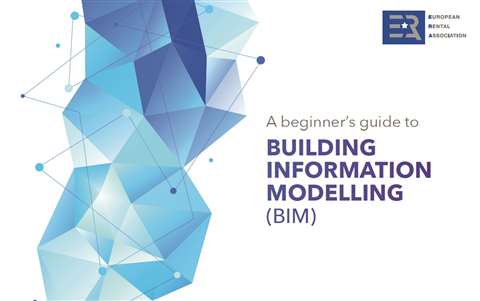 (Image: ERA)
(Image: ERA)
The guide can be downloaded for free. The association said BIM gives rental companies the opportunity, for the first time, to become involved at the design stage of a project.
By engaging in BIM, said the association, rental companies can help improve productivity, make sites more equipment friendly, and provide the optimum product for each stage of a construction project.
Michel Petitjean, ERA secretary general, says, “BIM is a transformative technology that represents a huge opportunity for the rental industry. “It enables rental companies to partner with their clients at an earlier stage by offering an expanded range of services, which means they can deliver greater value for money. This guide aims to make BIM more accessible to rental companies of all sizes and we hope that it helps the industry to embrace the technology and take advantage of the benefits that BIM has to offer for their businesses.”
The publication also gives case studies from leading rental companies that demonstrate some of the different uses for the technology.
STAY CONNECTED


Receive the information you need when you need it through our world-leading magazines, newsletters and daily briefings.
CONNECT WITH THE TEAM










